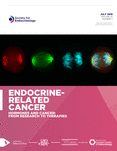Neoadjuvant palbociclib on ER+ breast cancer (N007): clinical response and EndoPredict’s value
- 1State Key Laboratory of Quality Research in Chinese Medicines, Macau University of Science and Technology, Macau SAR, Macao
- 2Organisation for Oncology and Translational Research, Hong Kong SAR, China
- 3UNIMED Medical Institute, Hong Kong SAR, China
- 4Department of Biomedical Statistics and Bioinformatics, Kyoto University Graduate School of Medicine, Kyoto, Japan
- 5Department of Pathology, Precious Blood Hospital, Hong Kong SAR, China
- 6Breast Surgery, Kyoto University Graduate School of Medicine, Kyoto, Japan
- Correspondence should be addressed to L W C Chow: lwcchow{at}ootr.org
-
Figure 2
(A) Overall change in Ki67 before and after treatment with neoadjuvant letrozole in combination with palbociclib. Each line represents the data for individual patient. Ki67 >15% was considered as high proliferation fraction. (B) Change in Ki67 before treatment, on day 15 and after treatment with neoadjuvant letrozole in combination with palbociclib. Each line represents the data for individual patient. Ki67 >15% was considered as high proliferation fraction.
-
Figure 5
Distribution of PEPI scores. A PEPI score of 0 predicts a low risk of recurrence; a score of 1–3 predicts an intermediate risk of recurrence; a score of 4 or higher predicts a high risk of recurrence. BCSS, breast cancer-specific survival; PEPI, preoperative endocrine prognostic index; RFS, relapse-free survival.
- © 2018 The authors












